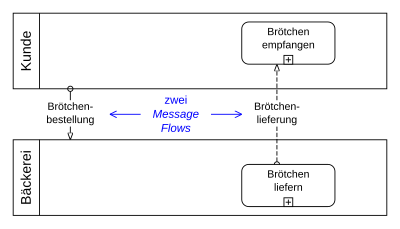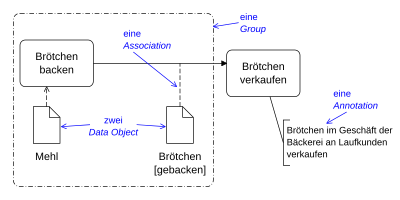Business Process Model and Notation
The Business Process Modeling Notation ( BPMN , German Business Process Model and Notation ) is a graphical specification language in the business computer science and process management . It provides symbols with which technical, method and IT specialists can model and document business processes and workflows .
development
The BPMN was developed from 2001 by the IBM employee Stephen A. White and published in 2004 by the Business Process Management Initiative (BPMI), an organization that had defined standards in the field of business process modeling. The swimlanes used by Stephen A. White for process visualization were developed in 1985 by Hartmut F. Binner for his process modeling tool " Sycat ". BPMN was taken over in June 2005 by the Object Management Group (OMG) for further maintenance. The BPMI merged with the OMG at the same time, so that the BPMN, like the Unified Modeling Language (UML), was the standard of the OMG from this point on. Since 2006, BPMN version 1.0 has been an official OMG standard. Version 1.1 was released in 2008, version 1.2 in 2009.
The current version of the BPMN standard, BPMN 2.0, was approved by the OMG in January 2011.
object
The focus of BPMN is on the notation , i. H. on the graphical representation of business processes. The standard document on BPMN also defines the semantics , i. H. the meaning of the symbols, whereby it attaches less weight to this aspect and does not emphasize formal definitions. Diagrams in BPMN are called Business Process Diagrams (BPD) and are intended to support the mapping or development of processes among human experts. A standardized format for saving and thus exchanging BPMN diagrams was not part of the specification up to version 1.2.
Version 2.0
Version 2.0, released in March 2011, standardizes an XML -based format in which BPMN diagrams can be saved. It is used for the exchange between different tools, for example between tools for modeling, simulation or the execution of process models.
BPMN 2.0 offers the following extensions compared to the 1.x versions:
- Formal description of what it means to execute an element of the BPMN ( execution semantics ).
- Possibility to extend BPMN yourself.
- Refined ways to compose and correlate events.
- Better support for describing the involvement of people in the processes ( human interaction ).
- Additional model for the choreography of processes.
On July 15, 2013, BPMN 2.0.1 was elevated to an international standard in ISO / IEC 19510: 2013.
Another aspect of process management is the ability to display the entire process landscape of an organization in a process map and the linking of business objects with the activities and message flows. The former is not yet available with version 2.0 either. Allocation to organization and roles is only possible in a rudimentary manner using pools and lanes, but not linked to an organizational model.
BPMN 2.0 enables a development towards BPM round-trip engineering. Specialized media attribute the potential to it to close the gap between organization and IT. First experiences with the XML-based format of BPMN 2.0 show a number of gaps, for example in the area of user interaction.
Link to execution languages
Machine-readable process descriptions have previously been formulated in execution languages for business processes, for example in the WS-Business Process Execution Language (WS-BPEL) or in the XML Process Definition Language (XPDL), both XML- based languages for describing processes. BPMN, BPEL and XPDL complement each other in that BPEL and XPDL are used where BPMN has gaps, namely in the execution semantics and in the storage format. With BPMN 2.0 it is to be expected that the importance of BPEL and XPDL will decrease, even if it will take some time, since they will probably continue to be used in the products developed so far. New products, on the other hand, rely on BPMN 2.0.
The BPMN standard defines how a BPMN diagram should be translated into BPEL so that the processes described can be carried out by software. The expressiveness of BPMN and BPEL is not the same. It should be noted that BPMN models are usually under-specified and abstract details relevant to execution. In addition, the translation of a BPMN model into a BPEL scheme will lead to semantic deviations in some cases. For example, BPEL is based on the block concept, which provides a paired symmetry of splitting and merging gateways, while BPMN does not recognize this restriction.
The Workflow Management Coalition (WfMC) defines an analogous translation for BPMN and XPDL. Images in other languages, such as ebXML , the Business Process Specification Scheme , are planned but not yet formulated.
Relationship to other modeling languages
BPMN is related to other languages / notations that are used in computer science for the modeling and visualization of business processes.
- Computer science has long known various forms of flowcharts with which program sequences are illustrated. The BPMN joins the tradition of these notations.
- BPMN is related to the event-driven process chains (EPC).
notation
The graphic elements of the BPMN are divided into
- Flow Objects - the nodes (Activity, Gateway and Event) in the business process diagrams
- Connecting Objects - the connecting edges in business process diagrams
- Pools and swimlanes - the areas with which actuators and systems are represented
- Artifacts - further elements such as data objects , groups and annotations for further documentation
We use the English names for the notation elements of the BPMN. Until 2006 there were no generally accepted German translations.
The process is usually horizontal and from left to right, analogous to the time axis in physical diagrams. In the case of loops, repetitions, revisions or the like, the return to an earlier point in the process chain may be made clear by a sequence flow connection.
Flow objects
An activity describes a task that has to be completed in a business process. It is shown as a rectangle with rounded corners. An elementary activity is Task , complex Activities are as Subprocess referred. They differ in the notation by a + symbol. Subprocesses can be displayed in a collapsed or expanded state.
A gateway (access) represents a decision point (split / fork), or a point at which different control flows converge (join / merge). It is drawn as a square on its tip . (Note: The English-language specifications speak here of Diamond Shape , which is translated as a rhombus , but the square is specified as the symbol.) Depending on the symbol inside the square, it stands for an AND, an OR or an XOR Gateway . In addition, other symbols within the square are used for event-based and complex gateways.
An event is something that can occur in a business process, for example the arrival of a message, the reaching of a certain date or the occurrence of an exceptional situation. Events are divided into three classes:
- according to their position in the business process in the start , intermediate and end event .
- according to their effect in the business process in catching event (reacts to trigger) and throwing event (provides result).
- according to their type in timer , message , exception event etc. For each event type, the notation has its own symbol that is displayed inside the circle symbol for the event .
Connecting objects
Sequence flows connect activities , gateways and events . They represent the order in which Activities are performed. A conditional flow is only run through if a certain condition is true, a default flow only if no other sequence flow can be run through.
A message flow indicates that two lanes or pools in a business process diagram or two elements of it are exchanging messages. Message flows only temporarily connect lanes , pools or flow objects .
Pools and swim lanes
A pool represents the main process participants, typically different organizations. A lane is a subdivision of a pool that extends over the entire length of the pool and represents a participant in a workflow , i.e. a user or a user role or a system.
Artifacts
An annotation is a comment that can be assigned to an element of a business process.
A data object represents an artifact that the business process processes. With Data Objects both electronic objects such as documents or records can be displayed as well as physical objects such as rolls or books.
A group is a tool to visually summarize elements of a business process. It is not to be confused with a subprocess .
See also
- free workflow management systems : Activiti , Camunda BPM , Imixs-Workflow, Yaoqiang BPMN Editor and Modelio
- commercial BPM tools: ADONIS , ARIS , BPM inspire , Enterprise Architect , ibo Prometheus, Innovator , PASS BPM, ProcessHub, FireStart, Semtalk , Signavio and Wonderware Skelta BPM
- UML tool
literature
- Thomas Allweyer: BPMN 2.0 Business Process Model and Notation. Introduction to the standard for business process modeling . 3. Edition. Books on Demand, Norderstedt 2015, ISBN 978-3-7386-2671-1 .
- Alexander Großkopf, Gero Decker, Mathias Weske: The Process: Business Process Modeling using BPMN . Meghan-Kiffer Press, Tampa 2009, ISBN 0-929652-26-6 .
- Guido Fischermanns: Practical Guide to Process Management . 11th edition. Publishing house Dr. Götz Schmidt, Gießen 2013, ISBN 978-3-921313-89-3 .
- Jakob Freund, Bernd Rücker: Practical Guide BPMN: With an introduction to CMMN and DMN . 5th edition. Hanser, 2017, ISBN 978-3-446-45054-7 .
- Bruce Silver: BPMN Method and Style, 2nd Edition, with BPMN Implementer's Guide: A Structured Approach for Business Process Modeling and Implementation Using BPMN 2 . Cody-Cassidy Press, 2011, ISBN 0-9823681-1-9 .
Web links
- Differences between the individual versions of BPMN (English-language Wikipedia)
- Comparison of BPMN tools (Wikipedia)
- BPMN tool matrix
- BPMN 1.1 poster (English; PDF file; 112 kB)
- BPMN 1.2 poster (with German translations of the BPMN terms; PDF file; 695 kB)
- BPMN 2.0 poster (German version, PDF file, 178 kB)
- BPMN 2.0 poster alternative link (German version against leaving personal information, PDF file)
- A series of videos of BPMN models with animated brand flow
- Official website of the OMG with specifications of the different BPMN versions
Individual evidence
- ↑ BPMN 2.0 for better collaboration between the specialist department and IT at Heise Online, January 22, 2011
- ↑ ISO / IEC 19510: 2013 English. Online at iso.org.
- ↑ Process modeler as "programmer"
- ↑ Wishes to BPMN 2.1 with regard to the feasibility ( memento of the original from November 24th 2010 in the Internet Archive ) Info: The archive link was inserted automatically and not yet checked. Please check the original and archive link according to the instructions and then remove this notice. on the SAPERION blog in English








